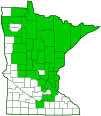wild calla
(Calla palustris)
Conservation • Wetland • Description • Habitat • Ecology • Use • Distribution • Taxonomy
Description |
||
Wild calla is a common plant in northern wetlands. It is found throughout northern Europe, northern Asia, and northern North America. In the United States it is found from Maine south to Pennsylvania and west to Minnesota. In Minnesota it is most common in the northeast, north-central, central, and metro regions, mostly absent in the southern third of the state and the far western counties. It is found usually within or adjacent to woodlands in a wide variety of wetlands, including bogs, fens, marshes, and swamps, and at the edges of ponds and lakes. It grows under partial sun to medium shade in acidic peaty soil or muck. Wild calla is a 4″ to 11″ tall perennial forb that rises on multiple leaves and flowering spikes from a horizontal stem (rhizome). The rhizome is ⅜″ to 1 3⁄16″ long, (1 to 3 cm) thick, and may be at or just below the surface of the soil. Leaves appear before the flowers. They arise singly at intervals along the rhizome and in a small cluster at the tip of the rhizome. If the rhizome is submerged the leaves rise out of the water. The leaves are 1 9⁄16″ to 5½″ (4 to 14 cm) wide, They are on 2⅜″ to 11 13⁄16″ (6 to 30 cm) long leaf stalks (petioles). The petioles are stout, 1½ to 2 times as long as the blade, longer if under water. The leaf blades are egg-shaped to nearly round, heart shaped at the base, and taper to a short point at the tip with concave sides along the tip. There is a central vein (midvein) at the base and numerous parallel lateral veins originating form the midvein and arcing toward the leaf tip. The upper leaf surface is bright green, hairless, and somewhat shiny. The margins are untoothed. The inflorescence is a spike with tiny flowers crowded on a thickened axis (spadix). The spadex is subtended by a single, large, petal-like bract (spathe). The spathe is white, egg-shaped to elliptic, and 1 3⁄16″ to 3⅛″ (3 to 8 cm) long. It is tube-like just at the base then broadly expanded. It does not enclose the spadix. It has an abrupt, green, ⅛″ to ⅜″ (4 to 10 mm) long, tip that is tightly rolled into a sharp point. The underside of the spathe is sometimes light green. The spadix is greenish-white, cylinder shaped, shorter than the spathe, ½″ to 1¼″ tall, and rounded at the tip. It is densely covered with numerous perfect (bisexual) flowers along its length, and with male (staminate) flowers just at the top. Individual flowers have 6 to 12 stamens but no floral leaves (sepals) and no petals. The stamens are white and surround a green, cone-shaped pistil. The fruit is a fleshy, pear-shaped, ¼″ to ½″ (6 to 12 mm) long, 3⁄16″ to ⅜″ (5 to 10 mm) wide berry with a few seeds. It is green at first, turning red at maturity. It is not embedded in the spadix. The spathe and spadix turn green in fruit. |
||
Height |
||
4″ to 11″ |
||
Flower Color |
||
White |
||
Similar Species |
||
Habitat |
||
Wet. Wetlands, including bogs, fens marshes, swamps, and edges of ponds and lakes. Partial sun to medium shade. Acidic peaty soil. |
||
Ecology |
||
Flowering |
||
May to July |
||
Toxicity |
||
All parts of wild calla are poisonous if ingested. Dried mature fruits can be consumed. Flour made from the rhizome can be consumed so long as the rhizome is dried, ground, leached, and boiled. However, flour made in this way should be used only “in times of need.” Humans may recover from a severe poisoning case but are likely to sustain permanent kidney and liver damage. |
||
Pests and Diseases |
||
|
||
Use |
||
|
||
Distribution |
||||
|
Sources |
|||
| 7/16/2023 | ||||
Nativity |
||||
Native |
||||
Occurrence |
||||
Common |
||||
Taxonomy |
|||
| Kingdom | Plantae (Plants) | ||
| Division | Tracheophyta (Vascular Plants) | ||
| Subdivision | Spermatophytina (Seed Plants) | ||
| Class | Liliopsida (Monocots) | ||
| Subclass | Alismatidae | ||
Order |
Alismatales (water-plantains, seagrass, and allies) | ||
Family |
Araceae (arum) | ||
| Subfamily | Calloideae (Aroideae) | ||
| Tribe | Calleae (marsh calla) | ||
Genus |
Calla (marsh callas) | ||
Calla palustris is placed in its own genus due to its unique combination of features, including bisexual flowers. All morphological and anatomical studies of Calla (Grayum, 1990, 1992; Bogner & Nicolson, 1991; Mayo & al., 1997, 1998; and Keating, 2004) placed the genus in a subfamily of its own, Calloideae. This has recently become controversial following several molecular phylogenetic studies (Keating, 2002, 2004; Cabrera & al., 2008; Chartier, 2011; Cusimano & al., 2011; and Nauheimer & al., 2012). Recent molecular classifications (Cabrera & al., 2008; Chartier, 2011; Cusimano & al., 2011; Nauheimer & al., 2012) place Calla within or “near to” the subfamily Aroideae. |
|||
Subordinate Taxa |
|||
|
|||
Synonyms |
|||
|
|||
Common Names |
|||
bog arum marsh calla water arum water-dragon wild calla wild calla-lily |
|||
Glossary
Bract
Modified leaf at the base of a flower stalk, flower cluster, or inflorescence.
Petiole
On plants: The stalk of a leaf blade or a compound leaf that attaches it to the stem. On ants and wasps: The constricted first one or two segments of the rear part of the body.
Rhizome
A horizontal, usually underground stem. It serves as a reproductive structure, producing roots below and shoots above at the nodes.
Sepal
An outer floral leaf, usually green but sometimes colored, at the base of a flower.
Spadix
A spike with small flowers crowded on a thickened, fleshy axis, usually enclosed in a spathe.
Spathe
One or two large bracts that subtend, hood, or sometimes envelope a flower or flower cluster, as with a Jack-in-the-Pulpit.
Visitor Photos |
|||||
Share your photo of this plant. |
|||||
| This button not working for you? Simply email us at info@MinnesotaSeasons.com. Attach one or more photos and, if you like, a caption. |
|||||
Luciearl |
|||||
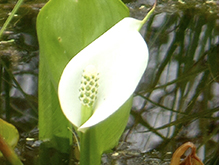 |
|||||
MinnesotaSeasons.com Photos |
|||||
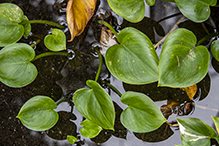 |
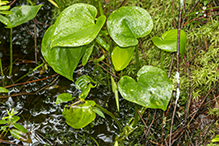 |
||||
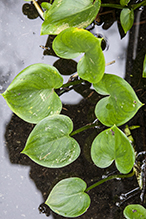 |
|||||

Slideshows |
||

Visitor Videos |
|||
Share your video of this plant. |
|||
| This button not working for you? Simply email us at info@MinnesotaSeasons.com. Attach a video, a YouTube link, or a cloud storage link. |
|||
Other Videos |
|||
| Calla palustris ďáblík bahenní Karel Filip |
|||
About
Jan 20, 2015 Vzácná jedovatá rostlina, ohrožený druh. Google translation: Rare poisonous plant, endangered species. |
|||

Created: 8/19/2020
Last Updated:
